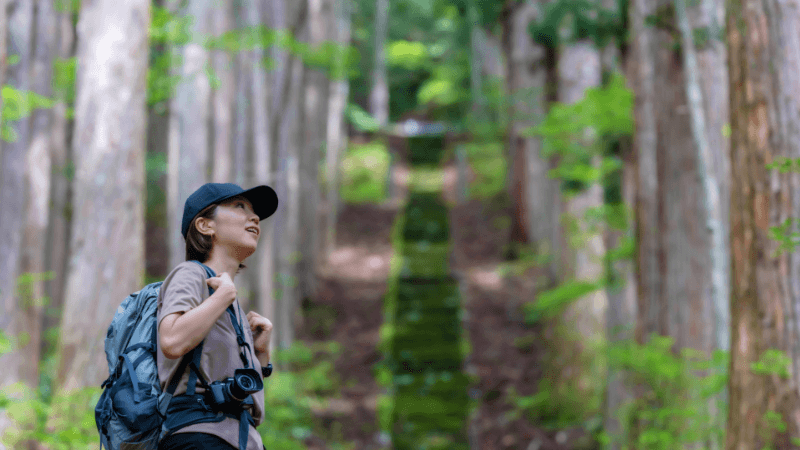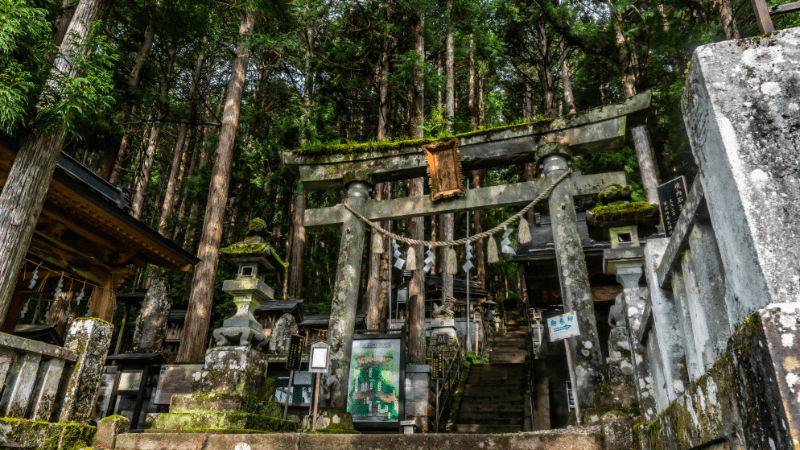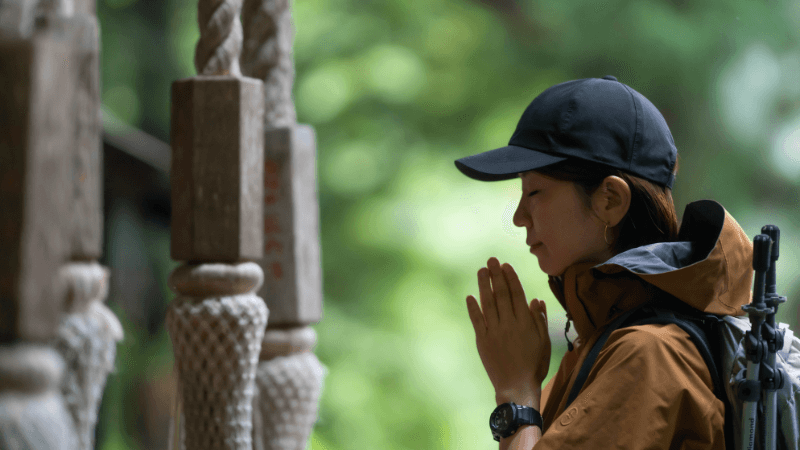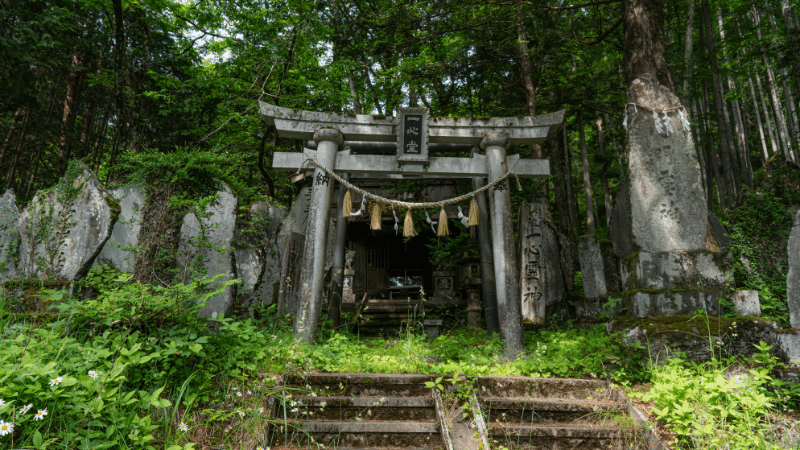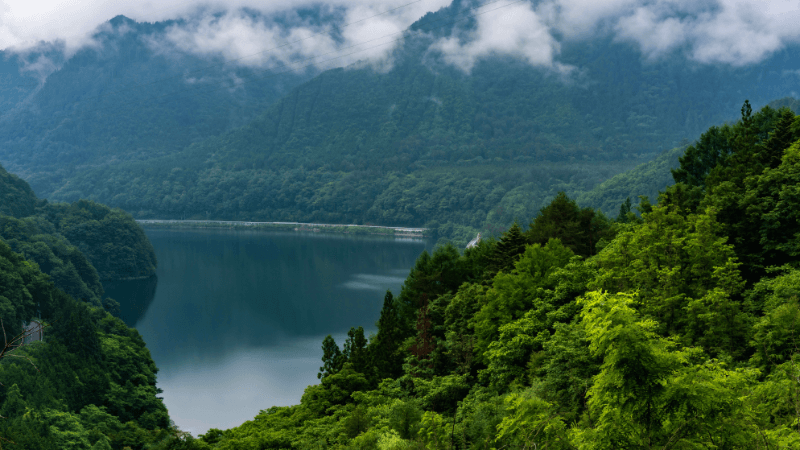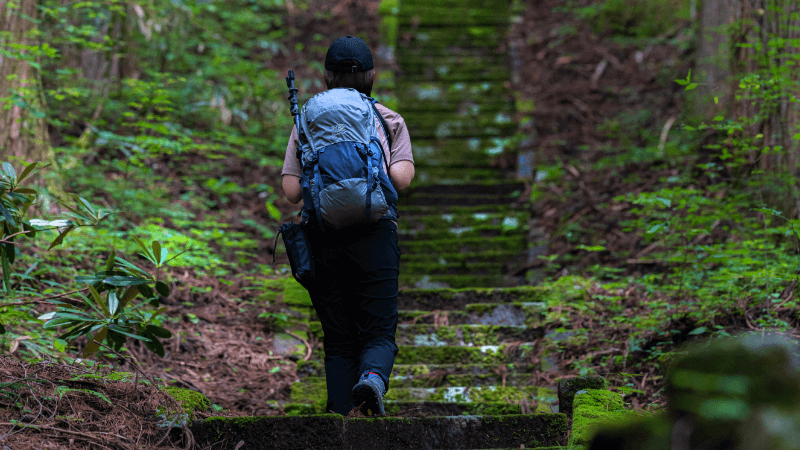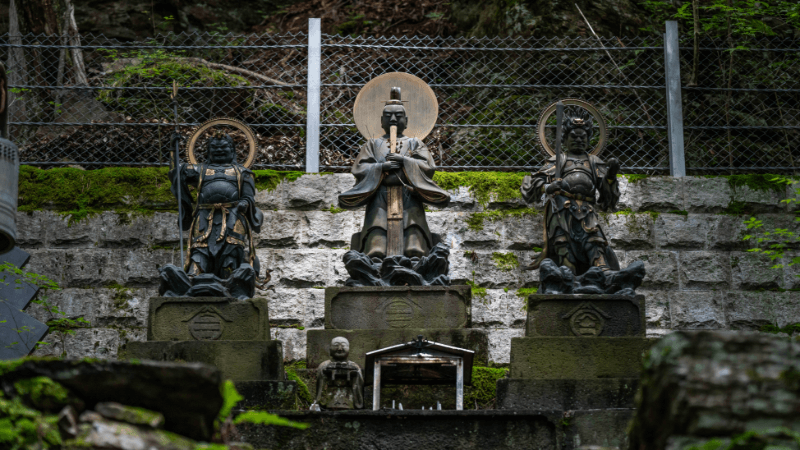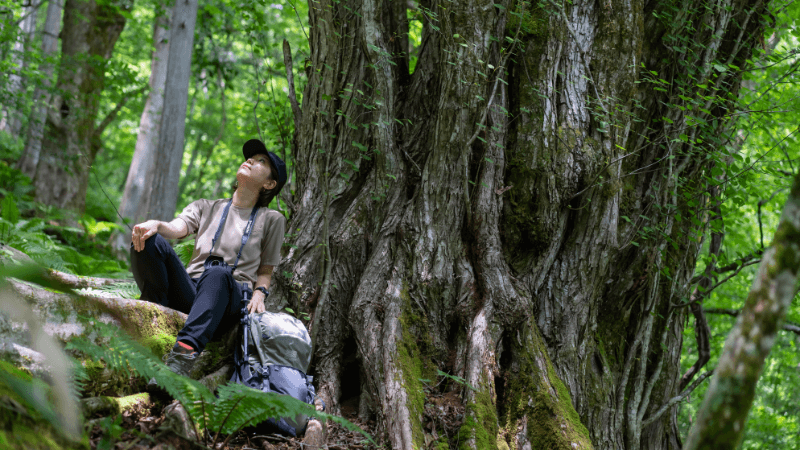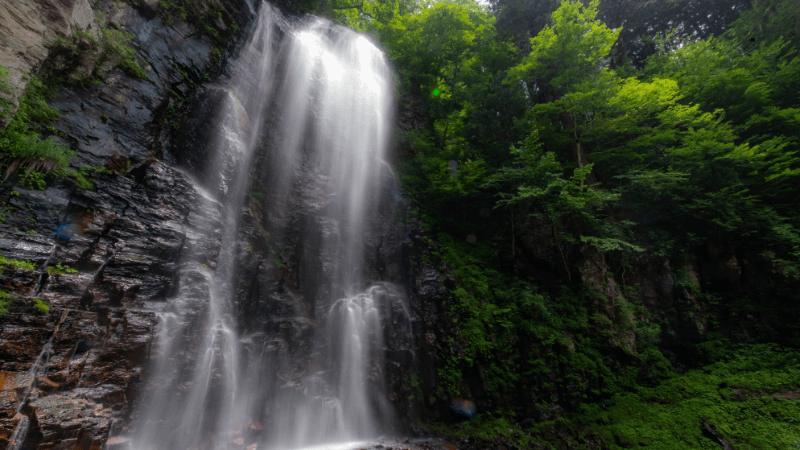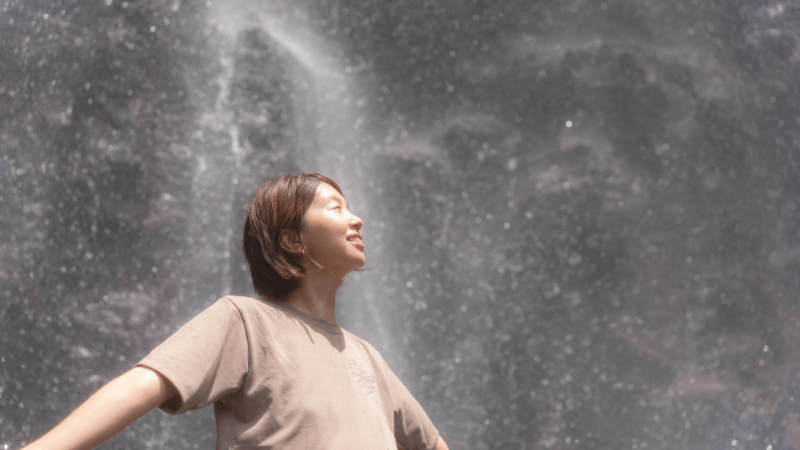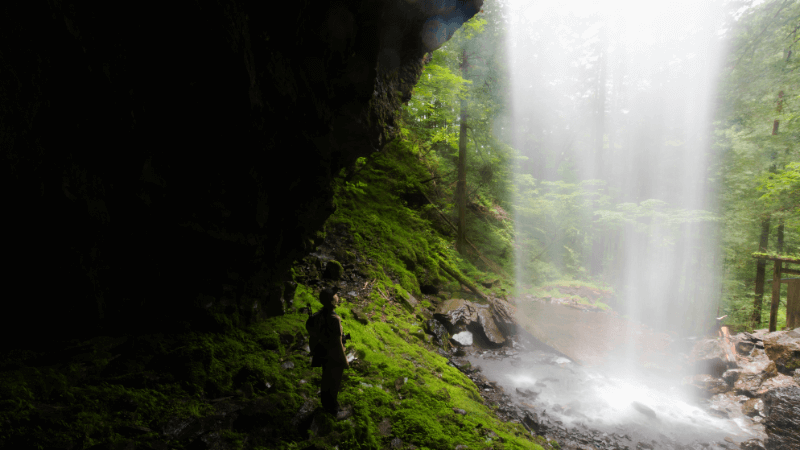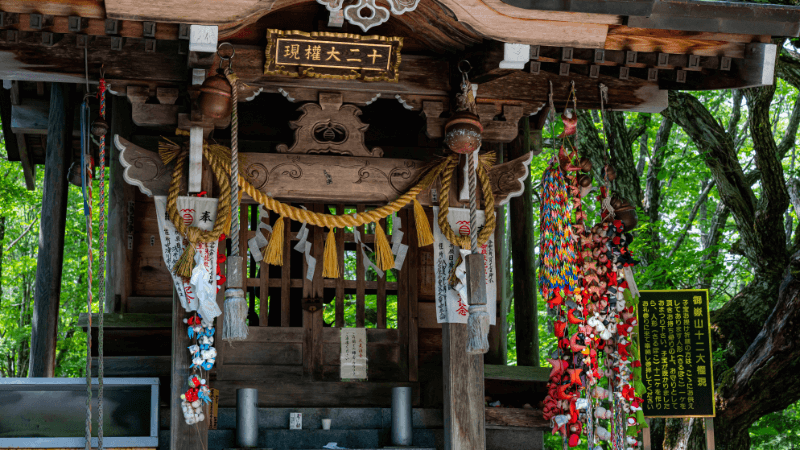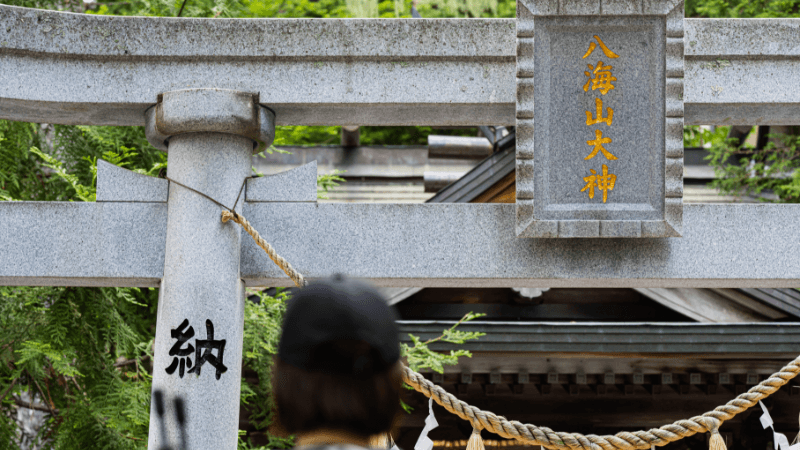 JP
JP

 JP
JP
There is an old road totaling 8.8 km that starts from the "Otake Tourist Information Center" on the west bank of the Ontake Lake, winding its way through nature to "Hakkaisan Shrine". It is a worshiping path opened by Fukan following the opening of the Kurosawa path by Kakumei in 1792. The essayist, Ayako Takeishi, visited the pure waterfalls and mountain roads where the sunlight shines through, conveying the thoughts and beliefs of the many people that have walked the same path.
1
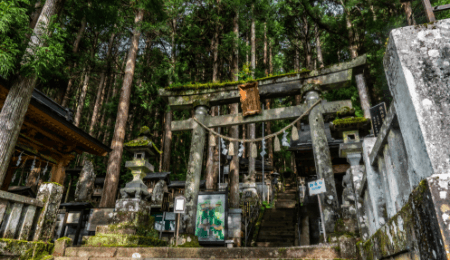
There is an old road totaling 8.8 km that starts from the "Otake Tourist Information Center" on the west bank of the Ontake Lake, winding its way through nature to "Mt. Hakkai Shrine". It is a worshiping path opened by Fukan following the opening of the Kurosawa path by Kakumei in 1792. The essayist, Ayako Takeishi, visited the pure waterfalls and mountain roads where the sunlight shines through, conveying the thoughts and beliefs of the many people that have walked the same path.
Address: 3315 Otakimura Higashi, Kiso District, Nagano Prefecture Google MAP
2
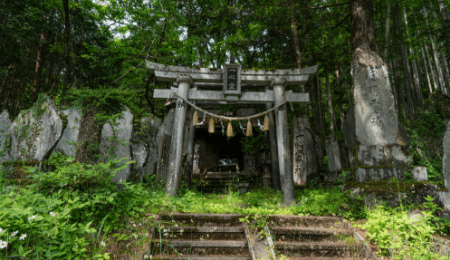
Mido (Enshrinement hall) was the last disciple of Fukan, who opened the mountain trail from the Otaki Entrance, to inherit his teachings. It is also believed to be the sacred place of the Mt. Ontake Otaki Entrace. The disciple traveled to various places in Shinshu and Kanto to spread the Ontake beliefs, so his importance led to him being known as the ancestor of the Ontake beliefs.
Address: 3229-1 Otakimura Higashi, Kiso District, Nagano Prefecture (facing Sakura Soba) Google Maps
3
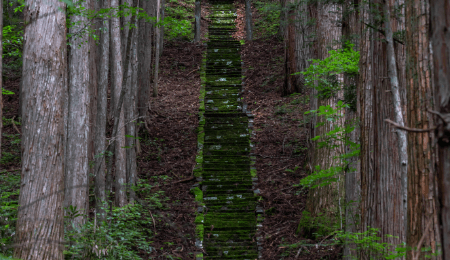
This shrine is located near the Omata Sanso Ryokan. At the top of the 383 steps, there is a stone monument, “Mt. Ontake Zao Dai Gongen”, where "Kuninotokotachi-no-Mikoto", "Onamuchi-no-Mikoto", and "Sukunahikona-no-Mikoto" are enshrined, in addition to "Hakkaisan Daizura Shinnno" from Niigata's Mt. Hakkai, and "Mt. Mikasa Toritengu" from Gunma's Mt. Mikasa, solicited by Fukan.
Address: 3159-5 Otakumura Omata, Kiso District, Nagano Prefecture Google Maps
4

This waterfall, with a head of 30m, was used for cleansing before the opening of the mountain trails by Kakumei and Fukan. It is said that those undergoing training for Mt. Ontake once stayed near this waterfall for 100 days (or 75 days) and cleansed their body and mind by this waterfall. It is still used for activities today, and Fudo Myo and Benzaiten are enshrined here.
Address: Otakimura Omata, Kiso District, Nagano Prefecture Google Maps
5
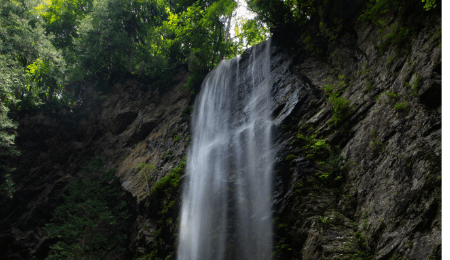
This waterfall, also known as "Uramino Fall", has a head of 30m. There is a large cavity in the back of the falls in which gods of Ontake are enshrined. In the past, worshippers who did not forego training would be secluded in the hollow and not be trained. Even today, there is a bunker built for worshippers near the falls.
Address: Otakimura, Kiso District, Nagano Prefecture Google Maps
6
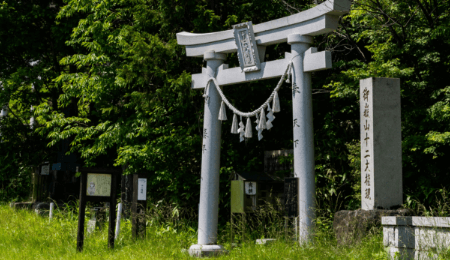
「"Konohanasakuya Himei" is enshrined at this shrine. It is believed that if you bring back a monkey boko (small doll), it will bring good luck for a child and childbirth. When a wish is fulfilled and a child is born, it is customary to dedicate 12 monkey boko as a thank-you. Today, there are many monkey boko paid to the shrine.
Address: Otakimura Hakkaisan, Kiso District, Nagano Prefecture Google Maps
7
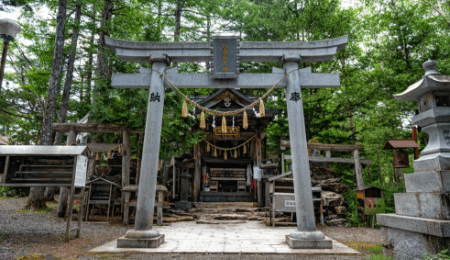
It is said that Fukan, who opened the Otaki mountain trail at Mt. Ontake, also opened up Mt. Hakkai in Echigo. Partly because of this, Fukan promoted the god of Mt. Hakkai, "Mt. Hakkai Daizura Shinnno", and solicited the Mt. Hakkai god to be enshrined here. The sacred water that springs up here behind the shrine is said to help heal eye diseases.
Address: Otakimura Hakkaisan, Kiso District, Nagano Prefecture Google Maps
Text: Ayako Takeishi (Social Hiker)
)
Photo: Tomohiko Yoshida
When heading to the mountains, people often aim for the summit. The sense of accomplishment you get when you struggle to the summit is irreplaceable. However, there are infinite ways to enjoy the mountains. One of the ways to do this is rather than aim for the peak of the mountain, to turn your gaze to the origins, history, and human activities along the “path” that lies there.
If a “path” exists, there is always a “person” who paved it. If there are people, there is always a “history” and a “story. You can walk slowly, following their footstep. All you need is a little information, curiosity, and imagination. In retrospect, even an ordinary road can look a little different. By following it carefully, the “information” at hand turns into a “story.

It was on a fine day during the rainy season. I went to the village of Otaki in Kiso, Shinshu, at the foot of Mt. Ontake.
Mt. Ontake is a famous 3000-meter class mountain. On this day, we decided to walk from the first station instead of taking the cable car, the more common method of accessing it. The course was the “Otaki Route”. It is an “old path” with a long history, paved in 1794 by a pilgrim named Fukan from Otaki Village (present-day Chichibu City, Saitama Prefecture) in Musashi. We passed through several sacred sites as we gradually gained altitude, aiming for the Hakkaisan Shrine at the fifth station.
We started at the 900-meter altitude point.
According to what I was told at the tourist information center, Otaki Village developed greatly economically, including apothecaries and lodgings, as worshippers from all over the country began to visit Ontake. That is why the existence of the founder, the pilgrim Fukan, is still talked about today. However, this achievement was not due to the existence of Fukan alone, but includes several people who worked behind the scenes to support him. This becomes apparent as you follow the course.
The mossy torii gate at Mitake Shrine. Beyond this is a long stone staircase with huge cypress and sawara trees.
First, I visited the Mitake Shrine, a sacred place of worship for the Ontake faith. The separate hall of the Mitake Shrine is near the first station at 王滝口and there is Satomiya a few minutes walk down the road. Beyond the torii gate, with its historic feel, there is a long flight of stone steps. I first climbed 67 steps and caught my breath. After climbing another 371 steps, you can see the shrine building standing against a high wall. I slowly clasped my hands together in prayer for the safety of my journey.
Surrounded by forests, the grounds of the Satomiya are very quiet and solemn.
After leaving the shrine, I walked along the stone wall to the shrine building, which is called “Kouzu Honsha”. It is also known as “Fukando”. The main shrine enshrines a standing statue of the pilgrim Fukan, the founder of Otakiguchi, his disciple pilgrims Isshin and Issan, as well as Kakumei, who paved Kurosawaguchi.
Walking further, looking at the trees and houses, I soon arrived at “Isshindo”.
Isshindo has many monuments to the spirits of the dead

In addition to paving the path, the pilgrim Fukan also trained many disciples to spread the ideas of the Ontake faith. It is said that his teachings spread throughout the country because his disciples, who inherited his dying wishes, worked to spread his faith in various places. One of the most dedicated of these was the pilgrim Isshin, who is enshrined in “Isshindo”.
While the activities of Isshin and his followers won the hearts of the people, they were treated as false prophets by the existing religious forces who were not comfortable with their message. He was suppressed by the Edo shogunate, and was eventually captured and exiled. Thanks to the efforts of his disciples to restore his master’s honor, they managed to get Isshin released, but he later died in exile. His teachings were maintained by his disciples and passed on to future generations.
There are people who are determined to create new trends, but when the circle of sympathy around them begins to grow, people with vested interests get in the way. Such situations seem to exist even today. Even after hundreds of years, perhaps the nature of human beings will never change. At the same time, however, teachings based on force of will are passed down through the generations, gaining the sympathy of people even after hundreds of years. This phenomenon also appears to be essential.
On the way, you can enjoy the beautiful view of Lake Ontakeko.
I walked along the road from Isshindo for a while. The local people called out to me. “If the weather was clear, the view of Ontake would be beautiful, so it’s a shame it’s like it is today.”. This is a matter of timing so can’t be helped. Thank goodness the downpour had been on the day before.
Once again, I saw the mossy torii gate and the stairs stretching straight up. This is the “Omatasansha”. I looked at the end of the stairs a little hesitantly, since I had just climbed up and down over 400 stone steps, and saw the gods sitting there.
Omatasansha has 383 stone steps leading straight up to the Ontake Sandaijin at the top of the mountain.
At the top of the mountain, Ontakesan Zaodaigongen, which is revered as the main deity of Shugendo, and Hakkaisan Ozurashino and Mikasayama Torigengu, recommended by Fukan, are enshrined.
Ontake Sandaijin is enshrined at the top of the mountain. It is said to have been enshrined for those who are unable to visit the sacred sites including the top of Mt. Ontake. I wonder if the endlessly long stone staircase was a form of pilgrimage, akin to climbing a mountain.
I took a break, feeling the history of the large trees along the path. The climate is cool and there is a pleasant breeze.
From the stairs of Omatasansha, I pass through a small path to Kiyo Falls.
As I was taking a break, I heard a rustling sound and turned around to see a big-eyed antelope staring at me as I walked away. Enjoying the calm and relaxed atmosphere, I felt that I understood a little bit how the old people felt who discovered God in the deep nature of Ontake.

We arrived at the Kiyo Falls, where Ontake worshippers have performed waterfall rituals since ancient times. Looking up from the bridge in front of us, I could hear the roar and huge sprays, probably a result of the rain from the previous day. The scene was both beautiful and severe at the same time.
Kiyo Falls slamming into the basin with a roar.
I had originally planned to just gaze at it, but I then decided to visit the rocky waterfall basin for a bit. As I put my hands together and dipped my feet with trepidation into the water, I felt my feet go numb from the cold, which was much more severe than I had imagined. As I approached the waterfall, I couldn’t help but flinch at its ferocity.
Just at the point where I could feel the spray of the water, I closed my eyes and took a deep breath. A feeling of release enveloped my whole body. I gradually became accustomed to the cold, and only the strength and movement of the water remained. It was the feeling of becoming one with nature. It seemed that I still needed to train my body and mind before I would be able to actually stand directly under the waterfall.
The dynamic flow of the water felt good. A changing room had also been prepared for waterfall climbers.
I climbed further up the wooden path, flapping to dry my soaking wet clothes. There was the sound of the river and birdsong. As I walked along, soothed by the sounds of nature, I heard the roar again, and arrived at “Shin Falls”. Water was flowing down violently from the bank, which was even higher than the Kiyo Falls, into the waterfall basin. I felt that what I was confronted with required the kind of determination that a pilgrim should have. Time passed quickly as I walked behind the waterfall and stared at the flowing water. How is it that we can look at fire and water forever without getting bored?
Behind the waterfall, there is a rock cave where pilgrims used to hole themselves up and practice asceticism, and where Fudomyo-o and Hachidairyu-o are enshrined. It is also called “Urami-no-taki” because it can be seen from the back.

This is the end of the course. As I had begun to get tired, I stopped by “Hanadofukando”. This is one of the four cemeteries where the bones were divided according to the will of Fukan himself. The descendants of Kichiemon Kotani, a woodcutter who guided Fukan on his ascent of the mountain, built a tea house and continue to maintain the temple today. Kichiemon later changed his name to “Yoshikami” and became a pilgrim.
It is said that in Kiso, where cypress is famous, the job of a woodcutter was a high-status occupation recognized by the shogunate. Kichiemon who had attained such a position, was so impressed by the spirit of the pilgrim Fukan that he volunteered to guide the way, even though he knew it was forbidden. I try to imagine (or fantasize) that such a passionate story may be based on at true tale.
Countless monuments to the dead remind us of the spread of Ontake faith.
The path to the sacred site continued amidst lush broadleaf trees.
When I reached the fourth station, I saw a pure white torii gate with the words “Junidaigongen” written on it. As I climbed the stone steps for the second time that day, I saw colorful dolls fluttering in the wind. There is a custom that worshippers who are wishing for the birth of a child take one of the dolls called “Saruboko” home with them, and when they are blessed with a child, they make twelve (!) “Saruboko” to thank the gods.
Junidaigongen:Konohanasakuya-hime is enshrined here. The Saruboko is hung on the right side.
On the path from this place to the destination, you can see the summit of Mt. Ontake, Mt. Kiso-Komagatake, and the Central Alps provided the weather is good. As we finally arrived at our destination, the “Hakkaisan Shrine”, I was at the mercy of the information board that said “XX meters to the next point”. I increased my altitude little by little, and before I realized it, I was at the 1670 meter point.
The main shrine enshrines Hakkaisan Ozurashinno who was consecrated by the pilgrim Fukan after he opened Hakkaisan in Echigo (Niigata), and within the premises, Marushitenson, Hachidairyuoson and Aizenmyo-o are enshrined. From curing eye conditions to bringing good luck to couples, this is a shrine of good fortune where the eight million gods (may) grant your request. At the end of the day, with a comfortable sense of fatigue, I headed to the main shrine and declared the safety of my journey.
At the end of the journey, visit Hakkai Shrine.
Although it is not a steep path, it is a truly luxurious course filled with forests, streams, and waterfalls in addition to the sacred sites. For example, it would be fun to simply bathe in the forest or just enjoy a waterfall.
However, a walking trip like this one, with its history and stories, can, to put it mildly, change the way you view landscape of the mountains and the path. It’s a little deep, and sometimes both tricky and mind-blowing. It is a path for which the feeling of having traveled remains. On this day, I fell in love with the mountains all over again.
View more Kurosawa Route